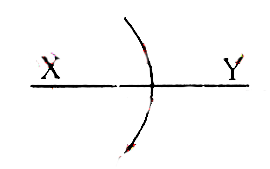(a) A point object is placed on the principal axis of a convex spherical surface of radius of curvature R, which separates the two media of refractive indices nx and n2(n2>n1)
Draw the ray diagram and deduce the relation between the object distance (w), image distance (v) and the radius of curvature (R) for refraction to take place at the convex spherical surface from rarer to denser medium.
(b) A converging lens has a focal length of 20 cm in air. It is made of a material of refractive index 1.6. If it is immersed in a liquid of refractive index 1.3, find its new focal length.
(a) N/A
(b) Focal length of lens in air f= + 20 cm, refractive index of glass ng = 1.6 and refractive index of liquid nl=1.3
If radii of curvature of two surfaces be R1 and R2, respectively, then in air:
1f=(ng−1)(1R1−1R2) i.e. 120=(1.6−1)(1R1−1R2) .........(i)
and on immersing the lens in given liquid, new focal length f. will be given by:
1f.=(ngn1−1)(1R1−1R2)=(1.61.3−1)(1R1−1R2) ...........(ii)
Dividing (i) by (ii), we get f.20=0.6×1.30.3⇒f.=52cm
Related Playlists
- BOOK - U-LIKE SERIESCHAPTER - RAY OPTICS AND OPTICAL INSTRUMENTSEXERCISE - SELF ASSESSMENT TEST (SECTION A)(MULTIPLE CHOICE QUESTIONS)5videos
RAY OPTICS AND OPTICAL INSTRUMENTS
- BOOK - U-LIKE SERIESCHAPTER - RAY OPTICS AND OPTICAL INSTRUMENTSEXERCISE - SELF ASSESSMENT TEST (SECTION A)(FILL IN THE BLANKS)3videos
RAY OPTICS AND OPTICAL INSTRUMENTS
- BOOK - U-LIKE SERIESCHAPTER - RAY OPTICS AND OPTICAL INSTRUMENTSEXERCISE - LONG ANSWER QUESTIONS-I38videos
RAY OPTICS AND OPTICAL INSTRUMENTS
- BOOK - U-LIKE SERIESCHAPTER - NUCLEIEXERCISE - Self Assessment Test10videos
NUCLEI
- BOOK - U-LIKE SERIESCHAPTER - SEMICONDUCTOR ELECTRONICS : MATERIALS, DEVICES AND SIMPLE CIRCUITSEXERCISE - SECTION B1videos
SEMICONDUCTOR ELECTRONICS : MATERIALS, DEVICES AND SIMPLE CIRCUITS
Similar Questions
A point object 'O' on the principal axis of a spherical surface of radius of curvature 'R' separating two media of refractive indices n1andn2 forms an image 'I' as shown in the figure below. Prove that n2v−n1v=n2−n1R
 View Solution
View SolutionA concave spherical surface of radius of curvature 100 cm separates two media of refractive indices 1.50 and 43. An object is kept in the first medium at a distance of 30 cm from the surface. Calculate the position of the image.
View SolutionA concave spherical surface of radius of curvature 100 cm separates two media of refractive indices 1.50 and 43. An object is kept in the first medium at a distance of 30 cm from the surface. Calculate the position of the image.
View SolutionA convex surface of radius of curvature 40 cm separate two media of refractive indices 43 and 1.50. An object is kept in the first medium at a distance of 20 cm from the surface. Calculate the position of the image.
View SolutionA convex surface of radius of curvature 40 cm separate two media of refractive indices 43 and 1.50. An object is kept in the first medium at a distance of 20 cm from the surface. Calculate the position of the image.
View SolutionA concave spherical surface of radius of curvature 10 cm separates two medium x & y of refractive index 4/3 & 3/2 respectively. If the object is placed along principal axis in medium X then
 View Solution
View SolutionAn object is placed at a large distance in front of a convex mirror of radius of curvature 40 cm . What is the distance of image from the mirror ?
View Solution(a) A point object, O is on the principle axis of a spherical surface having a radius of curvature, R. Draw a diagram to obtain the relation between the object and image distances, the refractive indicess of the media and the radius of curvature of the spherical surface.
View SolutionDraw a ray diagram to show the formation of the real image of a point object due to a convex spherical refracting surface, when the ray of light is travelling from a rarer medium of refractive index nx to a denser medium of refractive index n2 .
Using this diagram derive the relation between object distance (w), image distance (v), radius of curvature (R) of a convex spherical surface. State the sign convention and the assumptions used.View SolutionTrace the rays of light showing the formation of an image due to a point object placed on the axis of a spherical surface separating the two media of refractive indices n1andn2. Establish the relation between the distance of the object, the image and the radius of curvature from the central point of the spherical surface.
Hence derive the expression of the lens maker's formulaView Solution

